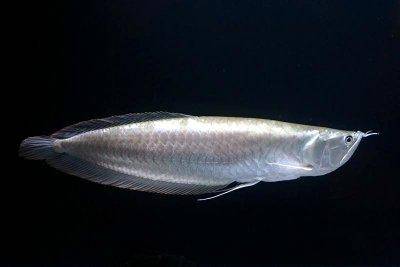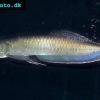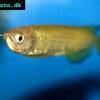Silver arowana - Osteoglossum bicirrhosum
Scientific name: Osteoglossum bicirrhosum
Common name: Silver arowana
Family: Osteoglossidae
Usual size in fish tanks: 90 - 100 cm (35.43 - 39.37 inch)
014
Recommended pH range: 6 - 6.6
Recommended water hardness: 4 - 12°N (71.43 - 214.29ppm)
0°C 32°F30°C 86°F
Recommended temperature range: 24 - 30 °C (75.2 - 86°F)
The way how these fish reproduce: Spawning
Where the species comes from: South America
Temperament to its own species: aggressive/territorial
Temperament toward other fish species: peaceful
Usual place in the tank: Middle levels
General information
Silver Arowana are classed as prehistoric fish, they have evolved only slightly compared to other species of fish on this planet. They also have a nasty bite as their tongue is also covered in small teeth so treat the Silver Arowana with respect and keep your fingers at a safe distance from the fishes mouth. As adults they can grow up to 4 feet in length so will require a very large aquarium. They are active swimmers so the aquarium needs to be at least three times their body length to give them space so an adult specimen will require an aquarium that is 12 feet in length, always remember this if you decide on purchasing a small juvenile that may be only a few inches in length. They are also excellent jumpers so the aquarium will need a tight fitting lid to prevent them from leaping out of the tank.
As expected with larger species of fish they are high waste producers and with the size of the aquarium required a large filtration system will be needed, keeping these fish for a long time is not cheap so make sure your allowed budget will let you cover all the needs that the Silver Arowana demands.
Feeding
Feed them live fish such as Guppies. You can also use beef heart. They do prefer live foods but this can restrict the choices available for your fish, with patience they should accept other meaty foods over a period of time.
Sexing
Possible when adults create pairs. These have been known to breed in aquariums when the conditions are right, the problems will start if you decide to raise the fry/juveniles as a lot of tanks will be required to grow them on.
Breeding
Mouthbrooders, the parent fish will incubate the eggs and hold the fry in their mouths until they reach a size and independence where the parents can release them into a safe environment.
Lifespan
Depending on the tank, it might vary from 4 up to 10 or even 15 years.
Pictures
Thanks to Kevin who has allowed us to use his pictures.









 Black
Black  Gulf
Gulf  Saratoga
Saratoga